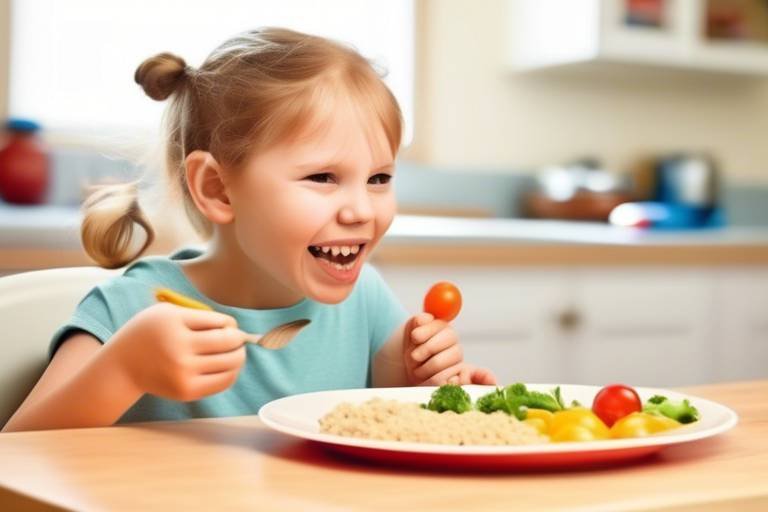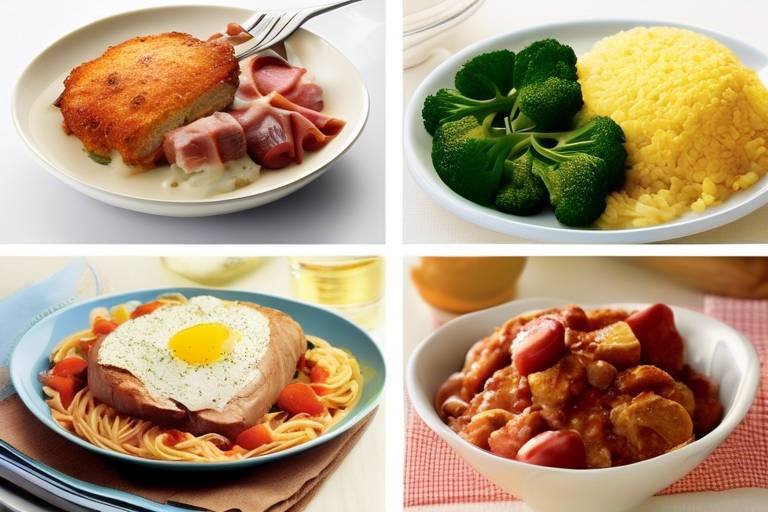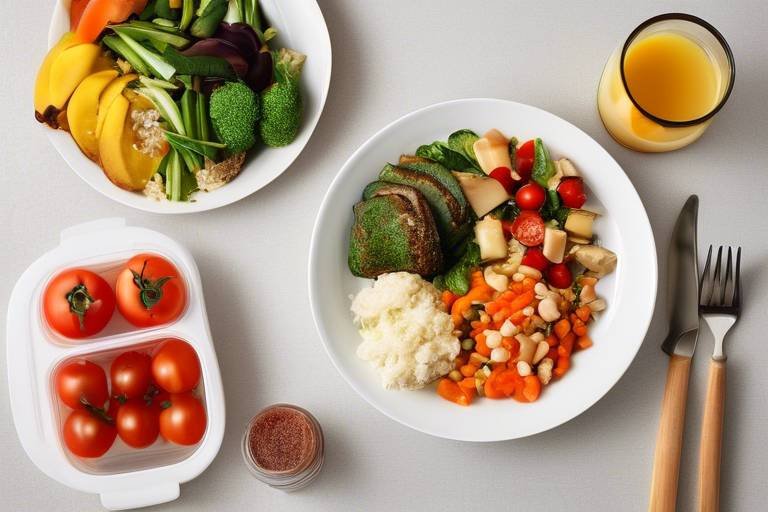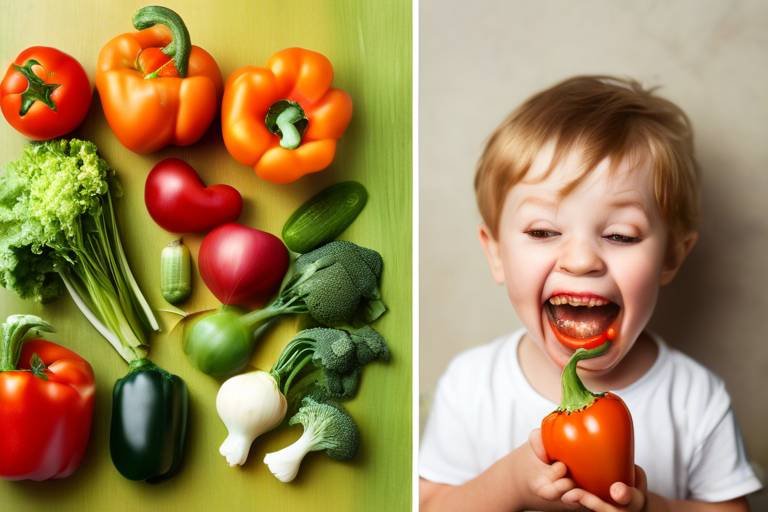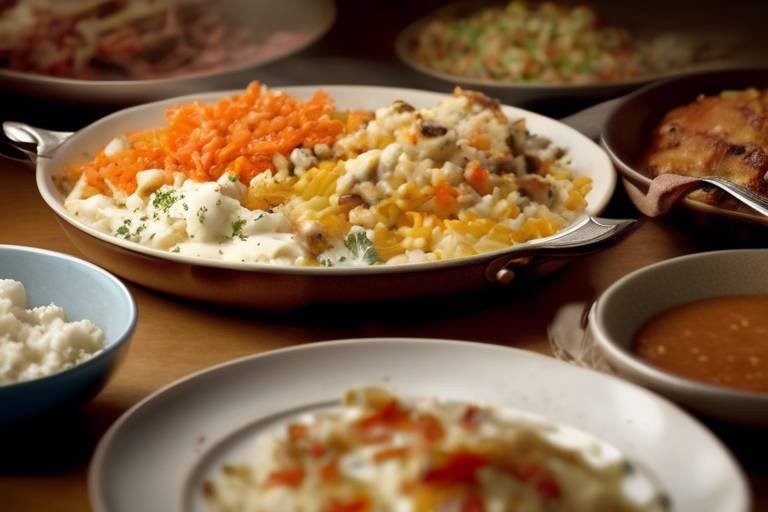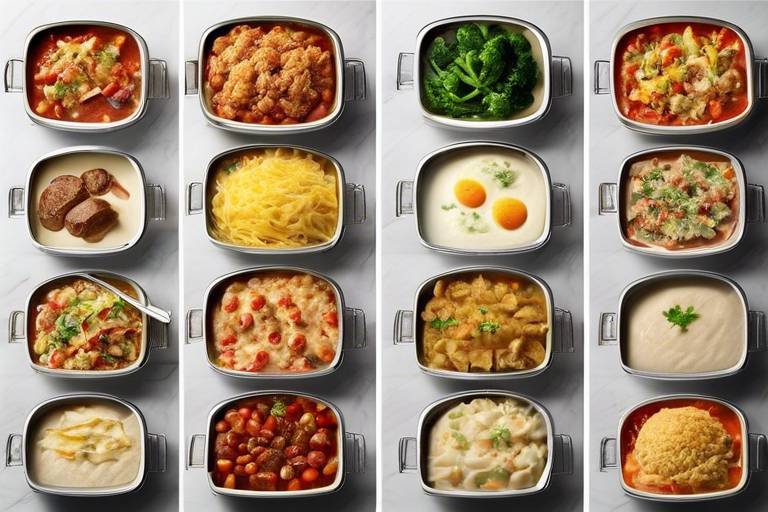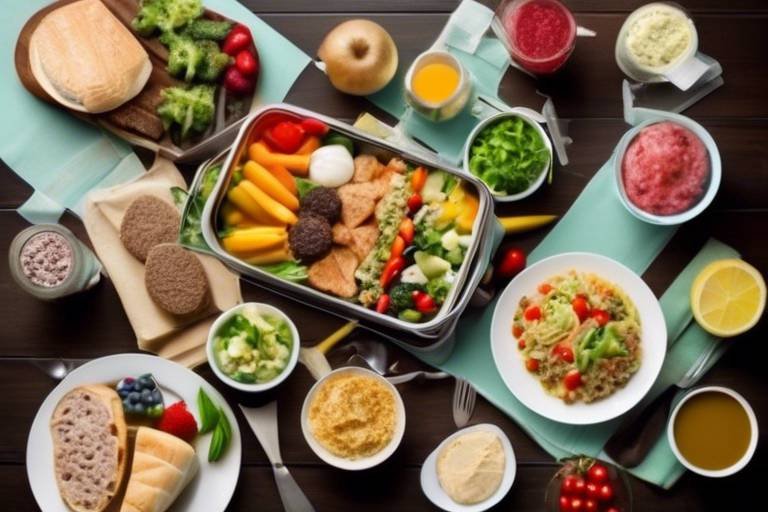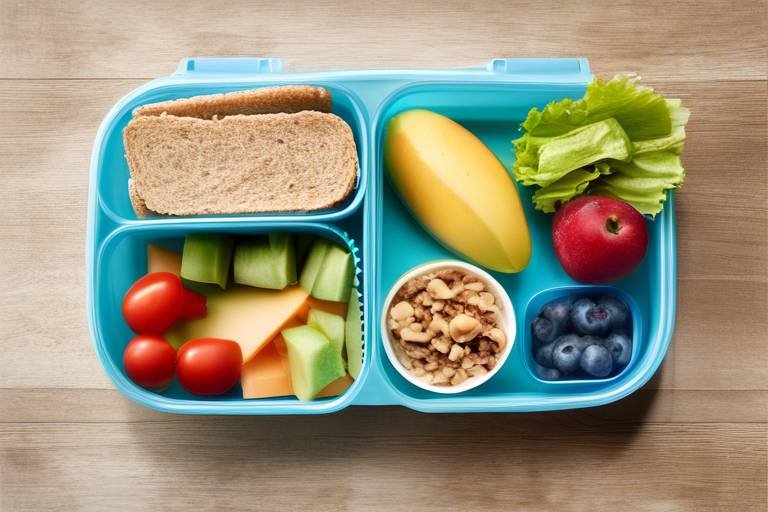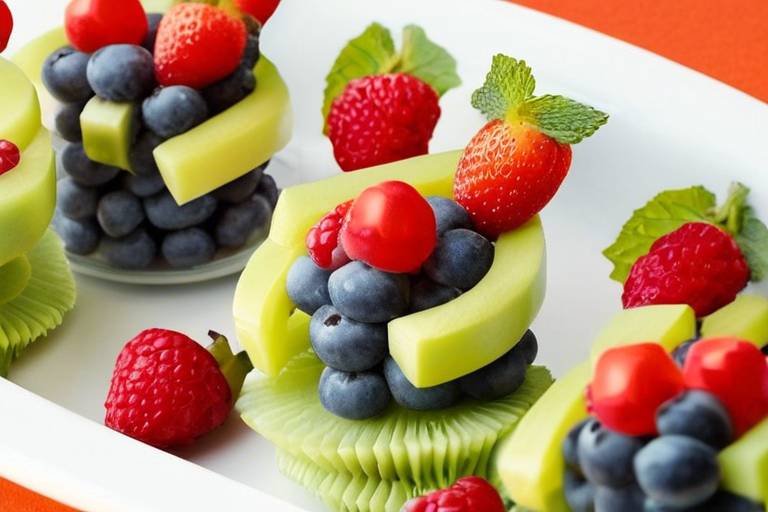Nutritious Meal Ideas for Children with Special Needs
When it comes to feeding children with special needs, the journey can sometimes feel overwhelming. However, with the right information and creativity, you can transform mealtime into an enjoyable and nutritious experience. Children with special needs often have unique dietary requirements that must be addressed to promote their health and well-being. This article explores a variety of meal options tailored specifically for these children, focusing on their dietary restrictions, preferences, and the importance of nutrition. By understanding their needs and incorporating essential nutrients into their meals, you can help them thrive.
Every child is unique, and for those with special needs, this uniqueness often extends to their dietary requirements. Some children may have allergies to common foods like gluten or dairy, while others might require a specific diet to manage conditions such as ADHD or autism. It's crucial to be aware of these dietary restrictions, as they can significantly impact a child's overall health and development. For instance, a child with gluten sensitivity may experience discomfort and digestive issues if gluten is included in their meals. Therefore, it’s essential to create a meal plan that is not only nutritious but also adheres to these dietary guidelines.
To support growth and development, children need a balanced intake of essential nutrients. These include vitamins, minerals, and proteins that play a vital role in their physical and cognitive development. For example, protein is essential for muscle growth, while healthy fats support brain development. It's not just about what they eat but also how these foods contribute to their overall health. A well-rounded diet can enhance their energy levels, improve focus, and promote better behavior. Remember, the goal is to create meals that are not only healthy but also appealing to children. After all, who wants to eat something that looks bland and uninviting?
When it comes to protein, there are numerous sources suitable for children. Lean meats, legumes, and dairy alternatives can all provide the necessary protein to support healthy growth. For instance, chicken and fish are excellent sources of lean protein, while beans and lentils offer plant-based options. Incorporating a variety of these foods into your child's meals can ensure they receive the protein they need without getting bored of the same flavors. Here’s a quick breakdown of some protein-rich foods:
| Food Source | Protein Content (per 100g) |
|---|---|
| Chicken Breast | 31g |
| Lentils | 9g |
| Greek Yogurt | 10g |
| Quinoa | 4g |
Plant-based proteins are not only nutritious but also versatile. Foods like beans, lentils, and quinoa can be easily incorporated into various dishes. For example, you can create a colorful bean salad with diced vegetables, or whip up a hearty lentil soup that’s full of flavor. These options are not just healthy; they can also be fun to prepare and eat! Mixing different colors and textures can make meals visually appealing, encouraging children to try new foods.
Traditional protein sources like chicken, fish, and dairy are also important. These foods can be prepared in kid-friendly ways to make them more appealing. For instance, try making chicken nuggets using whole grain breadcrumbs or bake fish with a flavorful crust. Dairy options such as cheese and yogurt can be great snacks or meal additions, providing not only protein but also calcium for strong bones. The key is to make these meals fun and engaging, perhaps by using cookie cutters to shape the food into fun designs.
Don’t underestimate the power of healthy fats! They are crucial for brain development and overall health. Foods like avocados, nuts, and seeds can be easily incorporated into meals and snacks. For example, a smoothie made with avocado can be creamy and delicious, while a handful of nuts can serve as a quick and nutritious snack. By including healthy fats in your child's diet, you can help support their cognitive function and energy levels throughout the day.
Now that we’ve covered the essentials, let’s dive into some creative meal ideas that are not only nutritious but also visually appealing! Making meals fun can encourage children to try new foods and enjoy their meals more. For breakfast, consider smoothies packed with fruits and spinach, or oatmeal topped with colorful berries. For lunch and dinner, experiment with wraps filled with lean proteins and vibrant veggies, or create a colorful stir-fry that’s sure to catch their eye.
Breakfast is often touted as the most important meal of the day, and for good reason! A nutritious breakfast can set a positive tone for the day ahead. Think about smoothies that blend fruits with spinach for a nutrient boost, or oatmeal topped with honey and banana slices. Egg dishes can also be a hit—try scrambled eggs with cheese and veggies, served in a fun shape. The goal is to provide energy and essential nutrients in a way that’s engaging for kids.
For lunch and dinner, there are countless options to explore. How about a colorful quinoa salad with mixed vegetables and a light dressing? Or perhaps a homemade pizza topped with lots of veggies and lean meats? These meals can cater to various tastes and preferences, ensuring that children receive balanced nutrition throughout the day. The secret lies in making the meals visually appealing and tasty, so they look forward to mealtime!
Healthy snacks are vital for maintaining energy levels between meals. Instead of reaching for processed snacks, consider offering fruits and vegetables that are easy to prepare and fun to eat. Think about apple slices with peanut butter or carrot sticks with hummus. These snacks not only provide essential nutrients but also keep kids satisfied until their next meal.
Fruits and vegetables are the cornerstones of a healthy diet. They are packed with vitamins, minerals, and fiber, making them essential for overall health. To encourage children to enjoy these food groups, try incorporating them into snacks creatively. For instance, you could make fruit kabobs with a variety of colorful fruits, or create a rainbow vegetable platter with hummus for dipping. The more vibrant and fun the presentation, the more likely they are to dig in!
Homemade snacks can be both nutritious and appealing. Consider making energy balls with oats, nut butter, and honey, which are easy to prepare and delicious. Another fun idea is to bake your own healthy granola bars using oats, nuts, and dried fruits. This way, you control the ingredients, ensuring they are free from unnecessary additives. Providing children with healthy options throughout the day helps to establish good eating habits that can last a lifetime.
Q: How can I ensure my child is getting enough nutrients?
A: Focus on providing a variety of foods from all food groups, including fruits, vegetables, whole grains, proteins, and healthy fats. Consulting with a healthcare provider or nutritionist can also help tailor a diet to your child's specific needs.
Q: Are there easy recipes I can prepare for my child?
A: Absolutely! Simple recipes like smoothies, wraps, and baked dishes can be both nutritious and easy to make. Look for kid-friendly recipes that involve minimal steps and ingredients.
Q: How can I make healthy eating fun for my child?
A: Get creative with food presentation! Use fun shapes, colorful ingredients, and involve your child in the cooking process. Making meals visually appealing can encourage them to try new foods.

Understanding Special Dietary Needs
When it comes to children with special needs, understanding their unique dietary requirements is crucial. These children often experience a range of challenges that can affect their eating habits, preferences, and nutritional needs. For instance, some may have food allergies or intolerances, while others might be on specific diets due to medical conditions such as autism or ADHD. It's essential to recognize that what works for one child may not work for another, making personalized meal planning a key aspect of their health and well-being.
Many parents find themselves navigating a maze of dietary restrictions. Common considerations include:
- Gluten-Free: Some children may be sensitive to gluten, a protein found in wheat, barley, and rye. A gluten-free diet can help alleviate symptoms and improve overall health.
- Dairy-Free: Lactose intolerance or dairy allergies can make it necessary to eliminate dairy products from a child's diet, which means finding alternative sources of calcium and vitamin D.
- Low-Sugar: For children with hyperactivity or other behavioral issues, reducing sugar intake can be beneficial. This often means avoiding processed foods and focusing on whole, natural ingredients.
- Nut-Free: Allergies to nuts are common and can be severe. It's vital to create a safe eating environment that avoids cross-contamination.
In addition to these dietary restrictions, some children may have specific sensory preferences that influence their food choices. For example, a child might prefer crunchy textures over soft ones, or they may be averse to certain colors or smells. Understanding these preferences can help in crafting meals that are not only nutritious but also enjoyable. It's all about finding a balance between meeting their nutritional needs and ensuring that they are excited about what they eat.
It's also worth noting that many children with special needs may have difficulty communicating their preferences or discomforts. This makes it even more important for caregivers to observe their reactions to different foods and be adaptable in their meal planning. Keeping a food diary can be an excellent way to track what works and what doesn't, providing valuable insights into a child's dietary habits.
Ultimately, the goal is to create meals that are both nutritious and enjoyable. By understanding and respecting each child's unique dietary needs, caregivers can foster a positive relationship with food, helping children thrive physically and emotionally. This journey may require creativity and patience, but the rewards are well worth the effort.

Incorporating Essential Nutrients
When it comes to the health and well-being of children with special needs, into their diets is paramount. These nutrients play a crucial role in their growth, development, and overall quality of life. But what exactly are these essential nutrients, and how can we make sure our little ones are getting enough of them? Let’s dive into this vibrant world of nutrition!
First off, we need to focus on vitamins and minerals, which are vital for various bodily functions. For example, Vitamin D is essential for bone health, while Iron is crucial for oxygen transport in the blood. Children with special needs may have different absorption rates or dietary restrictions that make it challenging to get these nutrients from their food. Therefore, a well-rounded approach to meal planning is necessary. You can consider including foods rich in these nutrients, such as:
| Nutrient | Food Sources |
|---|---|
| Vitamin D | Fatty fish, fortified milk, and egg yolks |
| Iron | Red meat, beans, spinach, and fortified cereals |
| Calcium | Dairy products, leafy greens, and fortified plant milks |
| Fiber | Whole grains, fruits, and vegetables |
Next up is protein, which is essential for muscle development and overall growth. For children with special needs, incorporating a variety of protein sources can help ensure they receive all the essential amino acids necessary for their body to function optimally. This can include lean meats, dairy, and plant-based proteins. The beauty of protein is that it can be easily integrated into meals without much fuss. Think of delicious chicken stir-fries, hearty bean soups, or creamy yogurt parfaits!
And let's not forget about healthy fats. These are not just a guilty pleasure; they are crucial for brain health and cognitive function. Foods like avocados, nuts, and seeds are fantastic sources of healthy fats and can be added to meals in various ways. Imagine a creamy avocado dip paired with colorful veggie sticks, or a sprinkle of chia seeds over a smoothie bowl—these not only taste great but also pack a nutritional punch!
In conclusion, incorporating essential nutrients into meals for children with special needs requires a thoughtful approach. By focusing on a mix of vitamins, minerals, proteins, and healthy fats, we can create a balanced diet that supports their unique needs. Remember, making meals visually appealing and fun can encourage children to try new foods and enjoy their meals. So, let’s get creative in the kitchen and make nutrition an exciting adventure!
Q1: What are the most important nutrients for children with special needs?
A1: The most important nutrients include vitamins (like D and C), minerals (such as Iron and Calcium), proteins, and healthy fats. These nutrients support growth, brain development, and overall health.
Q2: How can I ensure my child is getting enough nutrients?
A2: Offer a variety of foods from all food groups, including fruits, vegetables, whole grains, proteins, and dairy. Consulting with a healthcare provider or nutritionist can also help tailor a diet to your child's specific needs.
Q3: Are there any specific dietary restrictions to consider?
A3: Yes, some children may have allergies or intolerances to certain foods, such as gluten or dairy. It's essential to be aware of these restrictions and find alternative sources of necessary nutrients.
Q4: Can supplements help?
A4: Supplements can be beneficial, but it's best to consult with a healthcare provider before introducing them. Whole foods are always the preferred source of nutrients.

Protein-Rich Foods
When it comes to feeding children, especially those with special needs, play a pivotal role in their overall development. Protein is essential for building and repairing tissues, making enzymes and hormones, and it’s a crucial component of every cell in the body. For kids, this means that a diet rich in protein can support not just their physical growth but also their cognitive function. But what exactly should you include in their meals to ensure they’re getting enough protein?
First, let’s talk about some of the best sources of protein that are not only nutritious but also appealing to children. Lean meats like chicken and turkey are fantastic options. They are versatile and can be cooked in various ways to keep mealtime exciting. Fish, particularly salmon, is another excellent choice, packed with omega-3 fatty acids that are beneficial for brain health. If your child enjoys dairy, options like yogurt and cheese can be delicious sources of protein as well.
Now, let’s not forget about plant-based proteins! These are especially important for children who may have dietary restrictions or preferences that lean towards vegetarianism or veganism. Foods such as beans, lentils, and quinoa are not only rich in protein but also high in fiber, which aids in digestion. Incorporating these foods into your child’s meals can be as simple as adding some black beans to a taco or mixing lentils into a hearty soup.
| Protein Source | Protein Content (per 100g) | Health Benefits |
|---|---|---|
| Chicken Breast | 31g | Low in fat, high in essential amino acids |
| Salmon | 25g | Rich in omega-3 fatty acids, good for brain health |
| Greek Yogurt | 10g | High in probiotics, supports gut health |
| Lentils | 9g | High in fiber, promotes digestive health |
| Quinoa | 14g | Complete protein, contains all essential amino acids |
When preparing meals, consider mixing different protein sources to create a balanced plate. For instance, a stir-fry with chicken and a variety of colorful vegetables not only looks appealing but also packs a nutritional punch. You can also try making a protein-packed smoothie with Greek yogurt, spinach, and a banana. This not only provides protein but also includes essential vitamins and minerals, making it a great option for breakfast or a snack.
Ultimately, the goal is to make protein-rich foods both enjoyable and accessible for children. By experimenting with flavors and textures, you can create meals that not only meet their nutritional needs but also excite their taste buds. Remember, it’s all about finding what works best for your child and keeping mealtime fun!

Plant-Based Proteins
When it comes to nourishing our little ones, are a fantastic option that should not be overlooked. These proteins are not only rich in nutrients but also offer a variety of flavors and textures that can make meals exciting for children. Imagine a colorful plate filled with beans, lentils, and quinoa – it’s not just healthy; it’s a feast for the eyes!
One of the great things about plant-based proteins is their versatility. They can easily be incorporated into many dishes, from soups and salads to wraps and smoothies. For instance, lentils can be blended into a delicious and hearty soup, or they can be added to a veggie burger for an extra protein punch. Similarly, quinoa can be used as a base for a salad, mixed with colorful vegetables and a zesty dressing, making it a delightful meal that kids will actually want to eat.
Moreover, plant-based proteins are packed with essential nutrients that support growth and development. They are rich in fiber, which is crucial for digestion, and they provide a steady source of energy throughout the day. This is especially important for children with special needs, as they may require a balanced diet to help manage their energy levels and overall health.
Here are some excellent sources of plant-based proteins that you can include in your child’s diet:
- Beans: Black beans, kidney beans, and chickpeas are not only high in protein but also rich in fiber and iron.
- Lentils: These tiny powerhouses are packed with protein and can be easily added to various dishes.
- Quinoa: A complete protein that contains all nine essential amino acids, making it an excellent choice.
- Nuts and Seeds: Almonds, chia seeds, and hemp seeds are great for snacking and can be sprinkled on meals for added crunch and nutrition.
To make these plant-based proteins even more appealing, consider involving your children in the cooking process. Kids often enjoy meals more when they've had a hand in preparing them. Let them help rinse beans, mix ingredients for a veggie burger, or assemble a colorful quinoa salad. This not only teaches them valuable cooking skills but also encourages them to try new foods.
In conclusion, incorporating plant-based proteins into your child's diet is a delicious and nutritious way to support their health and development. With a little creativity and involvement, mealtime can transform into a fun and engaging experience that fosters healthy eating habits for a lifetime.
Q: Are plant-based proteins sufficient for my child's growth?
A: Yes! Plant-based proteins can provide all the essential nutrients your child needs. Just ensure a variety of sources to cover all amino acids and nutrients.
Q: How can I introduce plant-based proteins to my picky eater?
A: Start by mixing them into familiar dishes. For example, add lentils to spaghetti sauce or blend beans into a smoothie. Gradually introduce new flavors.
Q: Can plant-based proteins help with my child's energy levels?
A: Absolutely! They provide a steady source of energy and are often rich in fiber, which helps maintain energy levels throughout the day.

Meat and Dairy Options
When it comes to providing nutritious meals for children with special needs, incorporating a variety of meat and dairy options can play a crucial role in their overall health. These food groups are rich in essential nutrients that support growth and development. For instance, lean meats like chicken, turkey, and fish are not only excellent sources of protein but also provide vital nutrients such as iron and zinc, which are important for cognitive function and immune health.
One of the challenges parents face is making these foods appealing to children, especially those who may be picky eaters. To tackle this, consider preparing meals that are visually stimulating and fun. For example, you can create colorful wraps using whole grain tortillas filled with grilled chicken, shredded cheese, and a rainbow of veggies. Not only does this dish look appetizing, but it also ensures that your child is getting a balanced meal packed with protein, healthy fats, and fiber.
Dairy products are another fantastic option, providing calcium and vitamin D essential for strong bones and teeth. However, it's important to choose options that are low in added sugars and artificial ingredients. Greek yogurt is a great choice as it is thicker, creamier, and higher in protein compared to regular yogurt. You can serve it with fresh fruits or a sprinkle of granola for a delightful snack or breakfast. If your child is lactose intolerant or prefers dairy alternatives, there are numerous options available, such as almond milk or coconut yogurt, which can also provide similar nutritional benefits.
To make the most out of meat and dairy options, consider the following tips:
- Experiment with flavors: Use herbs and spices to enhance the taste of meats. For example, marinating chicken in a mixture of yogurt and spices can make it tender and flavorful.
- Incorporate into favorite dishes: Add shredded chicken or turkey to pasta dishes, or mix ground beef into homemade sauces to sneak in extra protein.
- Cheese as a topping: Sprinkling cheese on vegetables can make them more appealing. Try melting cheese over steamed broccoli or adding it to a vegetable bake.
By creatively incorporating meat and dairy into your child's diet, you can ensure they enjoy their meals while receiving the necessary nutrients for their growth and development. Remember, the key is to keep experimenting and adapting meals to suit their preferences while maintaining a focus on nutrition.
1. How can I encourage my child to try new meat and dairy options?
Engaging your child in the cooking process can make them more interested in trying new foods. Let them choose a recipe or help with preparation. Also, presenting food in fun shapes or colors can spark their curiosity.
2. Are there good alternatives for children with dairy allergies?
Absolutely! There are many dairy alternatives available, such as almond milk, soy yogurt, and cashew cheese. Just make sure to check labels for added sugars and nutrients.
3. How much protein do children with special needs require?
The protein needs can vary based on age, weight, and activity level. Generally, children should aim for about 10-30% of their daily calories from protein, but it’s best to consult with a pediatrician or nutritionist for personalized advice.

Healthy Fats
When it comes to feeding children, especially those with special needs, the inclusion of in their diet is paramount. These fats are not just a source of energy; they play a vital role in brain development, hormonal balance, and overall health. Imagine healthy fats as the fuel that powers a high-performance engine—without them, the engine simply cannot run at its best. So, what are some sources of these essential fats, and how can we incorporate them into our children's meals?
First off, let's talk about avocados. These creamy green fruits are packed with monounsaturated fats, which are known to support heart health. You can easily add avocado to smoothies, spread it on whole-grain toast, or even mash it up for a tasty dip. Not only are they delicious, but they also provide a wealth of vitamins and minerals. Pairing avocados with a sprinkle of lime juice and some salt can turn them into a fun and nutritious snack that children will love!
Nuts and seeds are another fantastic source of healthy fats. They are incredibly versatile and can be included in various meals and snacks. For instance, you could toss some chopped nuts into a bowl of oatmeal or blend them into a homemade energy bar. However, it's essential to be mindful of allergies, as some children may be sensitive to nuts. If that's the case, consider using seeds like chia or flaxseeds, which are also rich in omega-3 fatty acids and can be sprinkled on salads or blended into smoothies.
Moreover, let’s not forget about fatty fish like salmon and mackerel. These fish are not only rich in healthy fats but also packed with protein and essential nutrients like vitamin D. Preparing fish can be as simple as grilling or baking it with some herbs and lemon for flavor. Children often enjoy fish tacos or salmon patties, which can make mealtime both fun and nutritious. Just imagine the delight on their faces when they see a colorful plate filled with tasty fish and fresh veggies!
| Healthy Fat Source | Benefits | Kid-Friendly Ideas |
|---|---|---|
| Avocados | Rich in monounsaturated fats and vitamins | Guacamole, avocado toast, smoothies |
| Nuts and Seeds | Great source of omega-3 fatty acids | Trail mix, oatmeal topping, energy bars |
| Fatty Fish | High in protein and omega-3s | Fish tacos, salmon patties, grilled fish |
Incorporating these healthy fats into your child's diet doesn’t have to be a chore. Instead, think of it as an opportunity to explore new flavors and textures together. You might even find that your child enjoys helping out in the kitchen, mixing up a batch of nut butter or creating a colorful salad with avocado and seeds. Remember, the goal is to make meals enjoyable and nourishing, setting a foundation for healthy eating habits that will last a lifetime.
Ultimately, healthy fats should be a staple in every child's diet. They not only provide essential nutrients but also make meals more satisfying and flavorful. So the next time you're planning your grocery list, be sure to add those avocados, nuts, and fish. Your child's health—and their taste buds—will thank you!

Creative Meal Ideas
When it comes to feeding children with special needs, creativity can be your best ally. Not only do we want to ensure that their meals are nutritious, but we also want them to be visually appealing and fun! After all, mealtime should be an enjoyable experience. Imagine a plate that looks like a rainbow, filled with vibrant colors and textures. This can spark excitement and encourage children to try new foods. Here are some delightful meal ideas that can transform ordinary eating into an extraordinary adventure!
Starting with breakfast, why not whip up some fun breakfast options that will kickstart your child's day? Think about smoothies that are not just delicious but also packed with nutrients. You can blend together bananas, spinach, and a scoop of nut butter for a creamy, energy-boosting drink. Or, consider making oatmeal a little more exciting by transforming it into a fruit parfait. Layer cooked oatmeal with yogurt and a variety of fruits like berries, peaches, or even a sprinkle of granola. It's like dessert for breakfast!
For lunch and dinner, the possibilities are endless. One idea is to create wholesome wraps using whole grain tortillas. Fill them with lean proteins such as grilled chicken or turkey, add some colorful veggies like bell peppers and spinach, and finish with a tasty spread like hummus or avocado. Not only are these wraps healthy, but they also allow for customization, making each meal unique to your child's tastes. You could even turn this into a fun family activity by letting your child choose their fillings!
Don’t forget about the power of theme nights. For instance, have a "Taco Tuesday" where you set up a taco bar. Provide various toppings such as shredded cheese, lettuce, diced tomatoes, and beans. Let your child assemble their own tacos. This interactive approach not only makes meals more enjoyable but also encourages children to explore different flavors and textures.
Now, let’s talk about snacks. Healthy snacks can be just as creative and fun! Think outside the box with homemade snack ideas that are easy to prepare. For example, you can make fruit kabobs using skewers to thread pieces of fruit like grapes, melon, and strawberries. This not only makes the fruit more appealing but also adds an element of play to snacking. Another great option is to create yogurt dips for veggies. Pair carrot sticks, cucumber slices, and bell pepper strips with a yogurt-based dip for a nutritious and crunchy snack. It’s all about making healthy choices exciting!
In conclusion, the key to nutritious meals for children with special needs lies in creativity and presentation. By transforming meals into an engaging experience, you can help your child develop a positive relationship with food. So, roll up your sleeves and get ready to make mealtime a delightful journey filled with exploration and nourishment!
Q: How can I encourage my child to try new foods?
A: One effective way is to involve them in meal preparation. Let them choose ingredients or help with cooking, making them more invested in what they eat.
Q: Are there any specific dietary restrictions I should be aware of?
A: Yes, many children with special needs may have allergies or intolerances. It's essential to consult with a healthcare provider to tailor their diet accordingly.
Q: What are some easy ways to incorporate more vegetables into my child's diet?
A: Try blending vegetables into smoothies, adding them to sauces, or using fun shapes to make them more appealing. You could also encourage your child to help grow a small garden, which can pique their interest in eating what they've grown.

Fun Breakfast Options
Breakfast is often dubbed the most important meal of the day, and for children with special needs, it can set the tone for their entire day. The key is to make breakfast not only nutritious but also fun and engaging! Think of breakfast as a canvas where you can paint a masterpiece of flavors, colors, and textures that will delight your child's senses. Imagine a plate filled with vibrant fruits, creamy yogurts, and crunchy cereals that beckon them to dig in. Here are some exciting breakfast ideas that are sure to please even the pickiest eaters.
One fantastic option is a smoothie bowl. It’s a delightful way to sneak in fruits and vegetables while allowing your child to customize their meal. Simply blend their favorite fruits, such as bananas, berries, and spinach, with yogurt or milk for a creamy base. Pour it into a bowl and let them add toppings like granola, seeds, or even a drizzle of honey. This not only makes breakfast visually appealing but also encourages creativity and independence at the breakfast table.
Another great breakfast idea is oatmeal. Oatmeal is a powerhouse of nutrition and can be dressed up in countless ways. You can prepare it with milk or water, and then let your child choose their favorite toppings. Some delicious options include:
- Fresh fruits like strawberries, blueberries, or sliced bananas
- Nut butter for a protein boost
- Chia seeds or flaxseeds for added fiber
- A sprinkle of cinnamon for flavor
And let’s not forget about egg dishes. Eggs are incredibly versatile and can be made in a variety of ways that appeal to kids. From scrambled eggs to omelets stuffed with colorful veggies and cheese, the possibilities are endless! You could even make fun shapes using cookie cutters, turning a simple breakfast into a playful experience. Pair these with whole-grain toast or a side of fruit, and you've got a balanced meal that’s both satisfying and nourishing.
Finally, consider creating a breakfast bar. Set up a small station with different components for your child to assemble their own breakfast. This could include:
| Base | Toppings | Extras |
|---|---|---|
| Whole grain pancakes | Fresh fruits, chocolate chips, nuts | Yogurt, honey, maple syrup |
| Whole grain waffles | Peanut butter, jam, sliced bananas | Whipped cream, chia seeds |
This interactive breakfast option not only encourages children to make healthy choices but also allows them to feel a sense of control over their meals. When children are involved in the meal-making process, they are more likely to try new foods and enjoy what they eat.
In conclusion, breakfast can be a delightful experience filled with creativity and nutrition. By incorporating fun elements and allowing children to participate in their meal preparation, you can ensure they start their day off right, both in terms of health and happiness. So, why not turn breakfast into a joyful ritual that fuels their bodies and minds for the adventures ahead?

Wholesome Lunch and Dinner Recipes
When it comes to planning for children with special needs, creativity and nutrition go hand in hand. It's essential to create meals that not only meet dietary requirements but also tantalize the taste buds. Let's dive into some exciting meal ideas that are packed with nutrients and designed to appeal to young eaters.
One fantastic option is a colorful quinoa salad. Quinoa is a powerhouse of protein and is gluten-free, making it a great base for a variety of toppings. You can mix cooked quinoa with diced vegetables like bell peppers, cucumbers, and cherry tomatoes. Add a splash of olive oil and a squeeze of lemon juice for flavor. This dish is not only nutritious but also visually appealing, making it more enticing for children. Plus, you can customize it with their favorite veggies!
Another delicious choice is a chicken and vegetable stir-fry. Start by sautéing bite-sized pieces of chicken breast in a bit of olive oil. Once the chicken is cooked through, toss in a rainbow of vegetables such as broccoli, carrots, and snap peas. Season with low-sodium soy sauce or teriyaki sauce for an extra kick. Serve this stir-fry over brown rice or whole grain noodles for a complete meal that’s sure to satisfy.
For a comforting dinner option, consider making homemade turkey and vegetable meatballs. Mix ground turkey with finely grated zucchini, carrots, and breadcrumbs. Shape them into small balls and bake until golden brown. These meatballs can be served with whole grain spaghetti and a homemade tomato sauce, ensuring your child gets a hearty dose of protein and fiber. This meal can easily be made in bulk and frozen for quick dinners on busy nights.
Let’s not forget about the power of soups! A creamy vegetable soup made with pureed vegetables like carrots, potatoes, and spinach can be a great way to sneak in those essential nutrients. Use low-sodium vegetable broth as a base and finish it off with a splash of cream or a dollop of yogurt for added richness. Serve with whole grain bread for dipping, and watch as your child enjoys every spoonful.
To make mealtime even more interactive, consider creating a DIY taco bar. Set out whole grain tortillas, seasoned ground beef or beans, and a variety of toppings such as shredded cheese, lettuce, diced tomatoes, and avocado. This allows children to assemble their own tacos, making it a fun and engaging dining experience. Plus, it encourages them to try new ingredients!
In summary, wholesome lunch and dinner recipes for children with special needs can be both nutritious and enjoyable. By incorporating a variety of ingredients and flavors, you can create meals that not only meet dietary requirements but also excite young palates. Remember, the key is to keep it simple, colorful, and fun!
Q: What are some easy ways to ensure my child gets enough protein?
A: Incorporate protein-rich foods like lean meats, legumes, eggs, and dairy into meals. Consider snacks like yogurt or nut butter on whole grain toast.
Q: How can I make vegetables more appealing to my child?
A: Try serving vegetables with dips, blending them into smoothies, or incorporating them into favorite dishes like pasta or tacos.
Q: Are there any quick meal ideas for busy days?
A: Yes! Consider simple meals like scrambled eggs with spinach, whole grain wraps with turkey and cheese, or a quick vegetable stir-fry. Pre-prepared ingredients can save time.

Snacks That Nourish
When it comes to keeping our little ones energized and happy throughout the day, snacks play a pivotal role. For children with special needs, choosing the right snacks can be a delightful adventure that not only satisfies their taste buds but also provides essential nutrients. Think of snacks as mini-meals that can help bridge the gap between main meals, ensuring that kids are getting the vitamins, minerals, and energy they need to thrive. But how do we make these snacks both nutritious and appealing? Let’s dive into some exciting ideas!
First off, it’s crucial to recognize the importance of fruits and vegetables. These colorful foods are packed with vitamins and fiber, making them a fantastic choice for any snack time. You might be wondering, "How can I make fruits and veggies more enticing for my child?" Well, here are a few creative ideas:
- Fruit Kabobs: Skewer pieces of colorful fruits like strawberries, grapes, and melon on a stick. The vibrant colors and fun presentation can make eating fruit feel like a treat!
- Veggie Dips: Pair carrot sticks, cucumber slices, and bell pepper strips with a tasty hummus or yogurt dip. The creamy texture can encourage kids to munch on their veggies.
- Frozen Fruit Pops: Blend fruits with yogurt and freeze them in molds for a refreshing snack that feels like dessert!
Next, let’s talk about the power of homemade snacks. Preparing snacks at home allows you to control the ingredients and avoid hidden sugars and preservatives often found in store-bought options. Here are some simple recipes that are sure to please:
| Snack | Ingredients | Preparation |
|---|---|---|
| Peanut Butter Energy Bites | Oats, peanut butter, honey, chocolate chips | Mix ingredients, roll into balls, and refrigerate. |
| Yogurt Parfait | Greek yogurt, granola, mixed berries | Layer ingredients in a cup for a delicious treat. |
| Cheese and Crackers | Whole grain crackers, cheese slices, apple slices | Assemble for a balanced snack that’s easy to grab. |
Moreover, don’t underestimate the appeal of nut butter. Whether it’s almond, peanut, or sunflower seed butter, these spreads can be a hit among kids. Try spreading nut butter on whole grain toast or apple slices for a filling snack that packs a protein punch. It’s like a hug for their tummy!
Finally, let’s not forget about the importance of variety. Kids can be picky eaters, especially those with special needs. Introducing a range of flavors and textures can keep snack time exciting. Rotate snacks weekly, and involve your child in the selection process. Ask them what they’d like to try, or let them help with simple preparations. This not only makes them more likely to eat the snacks but also empowers them to make healthier choices.
In conclusion, nourishing snacks are essential for children, especially those with special dietary needs. By focusing on fruits, vegetables, homemade options, and nut butters, you can create a snack time that’s both fun and beneficial. Remember, the goal is to make healthy eating an enjoyable part of their daily routine!
Q: What are some quick snack ideas for busy parents?
A: Some quick options include yogurt cups, pre-cut fruits and veggies, cheese sticks, and whole grain crackers. These can be prepared in advance for grab-and-go convenience!
Q: How can I encourage my child to try new snacks?
A: Make it a fun game! Offer a “snack of the week” challenge where your child can pick one new snack to try each week. Celebrate their bravery with a sticker or small reward!
Q: Are there any snacks I should avoid?
A: Yes, try to limit snacks high in added sugars, artificial ingredients, and unhealthy fats. Always read labels and choose whole food options whenever possible.

Fruits and Vegetables
Fruits and vegetables are not just colorful additions to a child's plate; they are powerhouses of nutrition that can significantly enhance a child's health, especially for those with special needs. These foods are packed with vitamins, minerals, and fiber, which are essential for growth and development. However, getting children to enjoy these nutritious options can sometimes be a challenge. The key is to make these foods appealing and fun!
One effective strategy is to incorporate fruits and vegetables into meals in creative ways. For instance, consider making fruit smoothies that blend bananas, spinach, and berries. This not only masks the taste of greens but also creates a delicious, vibrant drink that kids will love. You can even involve your children in the preparation process, allowing them to choose their favorite fruits and vegetables, which increases their willingness to try new things.
Moreover, presenting fruits and vegetables in exciting shapes can spark a child’s interest. Use cookie cutters to create fun shapes from watermelon, cucumbers, or bell peppers. Arrange them on a plate to form a colorful rainbow, or create a "veggie art" masterpiece that they can eat after displaying. This not only makes mealtime fun but also encourages children to engage with their food.
Another great idea is to incorporate vegetables into dishes they already enjoy. For example, you can add finely chopped spinach or grated carrots into pasta sauces, or mix pureed vegetables into muffins or pancakes. This way, children get the nutrients they need without even realizing it!
To help parents understand which fruits and vegetables are most beneficial, here's a quick reference table outlining some of the best options and their health benefits:
| Fruit/Vegetable | Health Benefits |
|---|---|
| Spinach | Rich in iron and vitamins A, C, and K; supports brain health. |
| Carrots | High in beta-carotene; promotes good vision and immune function. |
| Bananas | Excellent source of potassium; helps with muscle function and energy. |
| Berries (strawberries, blueberries) | Loaded with antioxidants; supports heart health and brain function. |
| Broccoli | High in fiber and vitamins C and K; good for digestion and bone health. |
Incorporating a variety of fruits and vegetables into your child's diet doesn't have to be a daunting task. With a little creativity and patience, you can help your child develop a love for these nutritious foods. Remember, the goal is to make healthy eating a fun and enjoyable experience that they will carry with them into adulthood!
Q: How can I encourage my child to eat more fruits and vegetables?
A: One effective way is to involve them in the cooking process. Let them pick out fruits and vegetables at the grocery store, and allow them to help prepare meals. Making food visually appealing and fun is also a great way to entice them to try new things.
Q: What are some easy ways to sneak vegetables into meals?
A: You can finely chop or puree vegetables and mix them into sauces, soups, or baked goods. For instance, adding shredded zucchini to muffins or blending spinach into smoothies can help increase their vegetable intake without them noticing.
Q: Are frozen fruits and vegetables as nutritious as fresh ones?
A: Yes, frozen fruits and vegetables can be just as nutritious as fresh ones. They are often frozen at peak ripeness, preserving their nutrients. They can be a convenient and cost-effective option for busy families.

Homemade Snack Ideas
When it comes to keeping our little ones nourished, homemade snacks can be a game-changer, especially for children with special needs. Not only do they provide essential nutrients, but they also allow for creativity and fun in the kitchen! Imagine whipping up a batch of colorful fruit skewers that look like a rainbow, or crafting a creamy yogurt parfait that’s as delicious as it is nutritious. These snacks can be tailored to meet individual dietary restrictions while still being tasty and appealing.
One fantastic option is energy balls. These little bites are packed with protein and healthy fats, making them perfect for a quick pick-me-up. You can make them using simple ingredients like oats, nut butter, honey, and a sprinkle of chocolate chips or dried fruits. Not only are they easy to prepare, but kids can also help roll them into balls, making it a fun family activity. Here’s a simple recipe to get you started:
Energy Ball Recipe: - 1 cup rolled oats - 1/2 cup nut butter (peanut or almond) - 1/3 cup honey or maple syrup - 1/4 cup chocolate chips or dried fruits - 1/2 tsp vanilla extract Mix all the ingredients in a bowl, roll into balls, and refrigerate for an hour. Enjoy!
Another delightful homemade snack idea is vegetable muffins. These can be a sneaky way to incorporate veggies into your child’s diet without them even noticing! You can use ingredients like grated zucchini, carrots, or spinach, mixed with whole wheat flour and eggs. Not only are they nutritious, but they also make for a great on-the-go snack. Plus, you can customize them with your child’s favorite herbs and spices to enhance the flavor.
For a refreshing treat, consider making fruit and yogurt parfaits. Layering yogurt with fresh fruits and a sprinkle of granola can create a visually appealing snack that’s bursting with flavor. You can use a variety of fruits such as berries, bananas, or even mango, depending on what your child enjoys. This snack is not only tasty but also provides a good dose of calcium and vitamins.
Lastly, let’s not forget about homemade popcorn. Popcorn can be an excellent whole-grain snack, and making it at home allows you to control the ingredients. You can pop it on the stovetop or in an air popper, then add your favorite seasonings. Whether it’s a sprinkle of cheese, a dash of cinnamon, or even a light drizzle of olive oil, the options are endless! Kids love the crunch, and it’s a fun snack to enjoy during movie nights.
In conclusion, homemade snacks are not only a healthier alternative to store-bought options but also provide an opportunity for creativity and bonding in the kitchen. By involving your children in the preparation process, you can foster a love for healthy eating while ensuring they receive the nutrients they need to thrive. So, roll up your sleeves and get ready to whip up some delicious and nutritious snacks that your kids will love!
Q: What are some quick and easy snack ideas for children with special needs?
A: Quick and easy snack ideas include energy balls, vegetable muffins, fruit and yogurt parfaits, and homemade popcorn. These options are nutritious and can be prepared with minimal effort.
Q: How can I make snacks more appealing to picky eaters?
A: Try involving your children in the preparation process. Let them choose their favorite fruits or toppings, and present the snacks in fun and colorful ways to make them more enticing.
Q: Are there any snacks I should avoid for children with special dietary needs?
A: It’s essential to avoid snacks that contain allergens specific to your child, such as nuts, gluten, or dairy, depending on their dietary restrictions. Always read labels carefully and opt for whole, unprocessed foods whenever possible.
Frequently Asked Questions
- What are some common dietary restrictions for children with special needs?
Children with special needs may have various dietary restrictions, including gluten-free, dairy-free, or nut-free diets. It's essential to understand these needs to create meals that are not only nutritious but also safe and enjoyable for them.
- How can I ensure my child gets enough protein?
To ensure your child receives adequate protein, incorporate a variety of sources such as lean meats, fish, eggs, beans, lentils, and dairy products. For those on plant-based diets, consider quinoa, tofu, and nuts as excellent alternatives.
- What are some fun breakfast ideas for children?
Fun breakfast options include colorful smoothies, oatmeal topped with fruits and nuts, and scrambled eggs with veggies. Making breakfast visually appealing can encourage children to eat healthily and enjoy their meals!
- How can I include more fruits and vegetables in my child’s diet?
You can include more fruits and vegetables by creating fun snacks like fruit kabobs, veggie sticks with hummus, or smoothies packed with greens. Engaging your child in the preparation can also make them more excited to eat these healthy options.
- What are some healthy snack ideas for children?
Healthy snack ideas include yogurt with fruit, homemade granola bars, and nut butter on whole-grain crackers. These snacks provide energy and essential nutrients to keep your child active throughout the day.
- Are there specific nutrients I should focus on for my child’s development?
Yes! Focus on essential nutrients such as vitamins A, C, D, calcium, iron, and omega-3 fatty acids. These nutrients play a crucial role in growth, brain development, and overall health.
- How can I make mealtime enjoyable for my child?
To make mealtime enjoyable, involve your child in meal preparation, create visually appealing plates, and introduce fun themes or colors. Making meals a family affair can also encourage positive eating habits.

